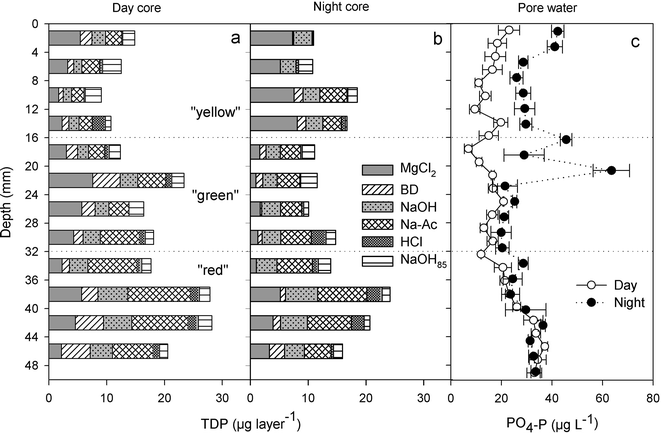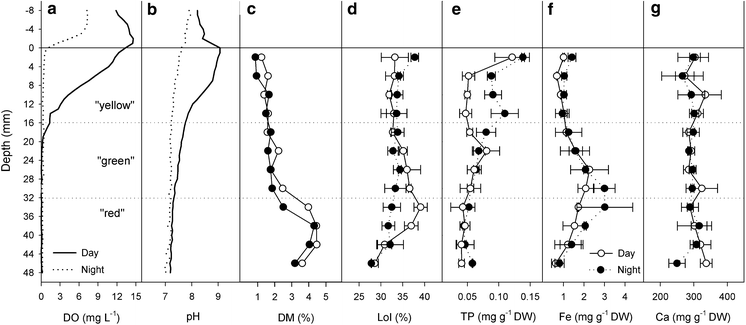 Spatial and temporal changes in phosphorus (P) distribution, partitioning and mobility in the benthic cyanobacterial mat (CBM) were evaluated using sequential chemical fractionation. Total P (TP) content was extremely low, ranging from 0.025 to 0.1 mg g−1 DW. Exchangeable and loosely bound P, which we consider to be mainly associated with extracellular polymeric substances (EPS), constituted the most significant proportion of TP (up to 52%, 55 μg g−1 DW), followed by P associated with the authigenic apatites (up to 35% of TP or 18 μg g−1 DW). While we found virtually no exchange of P with the ambient environment, our results show that the partitioning of P forms within CBM is dependent on spatial and temporal fluctuations of physico-chemical parameters, mainly pH and dissolved oxygen. A conspicuous diurnal increase in the reactive, exchangeable and loosely bound P in the top CBM layers was observed. This observation has important ecological implications, as CBM microorganisms therefore have an increased possibility for P “luxury” uptake during the night. This hypothesis is further supported by the fact that P in the organic fraction rises by as much as 53% in the upper layers during the night, indicating some form of cellular uptake. The P-binding potential of EPS also has ecological or biogeochemical consequences and should be considered in stoichiometrical studies where it represents potential danger for great overestimates of cellular P values or the nutritional status of cells.
Spatial and temporal changes in phosphorus (P) distribution, partitioning and mobility in the benthic cyanobacterial mat (CBM) were evaluated using sequential chemical fractionation. Total P (TP) content was extremely low, ranging from 0.025 to 0.1 mg g−1 DW. Exchangeable and loosely bound P, which we consider to be mainly associated with extracellular polymeric substances (EPS), constituted the most significant proportion of TP (up to 52%, 55 μg g−1 DW), followed by P associated with the authigenic apatites (up to 35% of TP or 18 μg g−1 DW). While we found virtually no exchange of P with the ambient environment, our results show that the partitioning of P forms within CBM is dependent on spatial and temporal fluctuations of physico-chemical parameters, mainly pH and dissolved oxygen. A conspicuous diurnal increase in the reactive, exchangeable and loosely bound P in the top CBM layers was observed. This observation has important ecological implications, as CBM microorganisms therefore have an increased possibility for P “luxury” uptake during the night. This hypothesis is further supported by the fact that P in the organic fraction rises by as much as 53% in the upper layers during the night, indicating some form of cellular uptake. The P-binding potential of EPS also has ecological or biogeochemical consequences and should be considered in stoichiometrical studies where it represents potential danger for great overestimates of cellular P values or the nutritional status of cells.
Keywords: cyanobacterial mat; diurnal changes; EPS; phosphorus partitioning; sequential fractionation

